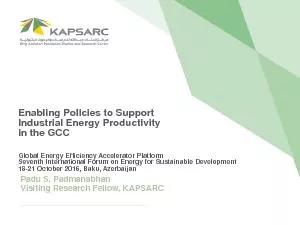

2 Source KAPSARCEnergy productivity is about maximizing economic value and welfare for society133 3 GCC countries could extract more value out of their industrial energy consumption SourceIEAandEn ID: 827457
Download Pdf The PPT/PDF document "Enabling Policies to Support Industrial ..." is the property of its rightful owner. Permission is granted to download and print the materials on this web site for personal, non-commercial use only, and to display it on your personal computer provided you do not modify the materials and that you retain all copyright notices contained in the materials. By downloading content from our website, you accept the terms of this agreement.
Enabling Policies to Support Industrial
Enabling Policies to Support Industrial Energy Productivity in the GCCGlobal Energy Efficiency Accelerator Platform Seventh International Forum on Energy for Sustainable Development21 October 2016, Baku, AzerbaijanPadu S. PadmanabhanVisiting Research Fellow, KAPSARC2Source: KAPSARCEnergy productivity is about maximizing economic value and welfare for society…3GCC countries
could extract more value out of their in
could extract more value out of their industrial energy consumptionSourceIEAandEnerdata(shadingindicatesindividualcountrieswithineachsector)4BahrainKuwaitOmanQatarSaudi ArabiaUAEComposition of Value Added by Sector 2014Other ServicesAgriculture, hunting, forestry, fishingWholesale, retail trade, restaurants and hotelsConstructionManufacturingTransport, storage and communica
tionMining, UtilitiesStrong transition
tionMining, UtilitiesStrong transition towards services will also help lift energy productivity…Source: UNSTAT5Providing an evidence base for target setting and….. Source: Adapted from IEA energy indicators pyramidGDP/TFCSectoralenergy productivitySubsectoralenergy productivity.Aggregated indicatorsDisaggregated indicatorsIndustry unit energy productivityProcess/equipm
ent indicatorsEconomy scale indicators:E
ent indicatorsEconomy scale indicators:Economy aggregate energy productivity: GDP/ (cost of domestic energy production + earnings from exports cost of energy exports)Sectoralscale indicators: Sector value add/(cost of energy consumed or purchased by the sector)Subsectoralscale indicators:Subsector value add/(cost of energy consumed by the sub sector)Unit specific energy consumption:
Plant energy consumption / (physical uni
Plant energy consumption / (physical units produced) 6Data gathering to enable benchmarking performance is an important first step…Sources: UNIDO 2010 and UNESCWAIHS Industrial databaseNotes: *GCC benchmarks sample needs to be expanded EAF: Electric Arc Furnace BOF: Basic Oxygen FurnaceDeveloped countriesGCCaverageDevelopingcountriesMWh/tDeveloped countriesGCCaverageDevelop
ingcountriesAluminum smelting Global Av
ingcountriesAluminum smelting Global AverageEAFGCCaverageGJ/tMWh/tIron and steelCementWh/tGlobal AverageBOF7Energy Performance Indicators EnPIsfor each process/ sub processEnergy DataProcess / Sub Process DetailsProduction DataAnonymised aggregated cluster indicators on CEEDR sourced from EnPIs from EIMASEIMAS 3EIMAS 1EIMAS 2Centralised Energy Efficiency Data Repositor
yEnergy management systems at the organi
yEnergy management systems at the organisation level and a centralised energy efficiency benchmarking platform at the industry level8Five PhasesTen StepsTwenty ActionsFive ToolsPolicy Definition1.Formulate industrial EP regulations in legislative frameworkAnalyze legislative framework and regulatory drivers1.GAP analysis2.SEC normsProgram Planning2.Define program role in policy fr
ameworkAnalyze policy framework and indu
ameworkAnalyze policy framework and industrial context3. Design the programDefine scope and objectivesDefine Energy Management System (EnMS3. ISO 50001: Energy Mgt. System4. Establish Action Plans and mobilize resourcesEstablish Management Information Systems (MIS)Create Action PlanSecure resourcesProgram Implementation5. Provide Institutional supportConduct energy audits; ESCOs per
formance contractsDevelop training strat
formance contractsDevelop training strategy :institutional and human capacityFollowup with companies and assist in implementation4. Energy audit tools & practicesMonitoring & Evaluation6. Establish M&E protocolsEstablish verifiable indicators and data sourcesMeter & submeter facilitiesEstablish baselines5. Benchmarking7. Assess complianceUse transparent & predefined criteriaEstablis
h rewards or penalty mechanisms8. Evalua
h rewards or penalty mechanisms8. Evaluate programDefine evaluation objectivesSelect evaluation approach and indicatorsReporting9. Promote programAddress challenges and failures10. Revise and adapt prog.Adjust program design and consider upscalingIndustrial energy efficiency policy pathways9Saudi Arabia’s INDC identifies two potential pathways for developmentAccelerated indus
trialization based on low cost abundant
trialization based on low cost abundant energy resourcesEnergy export revenue and investment into energy efficiency, RE, and high value servicesINDC Target: 130 million tCOe by 2030“Only possible” under scenario 1Scenario 1: igh energy productivity Oil allocated for exportScenario 2: Low nergy productivity Oil used domestically10Thank you and further information srini
vasan.padmanabhan@kapsarc.orgreachpadhu
vasan.padmanabhan@kapsarc.orgreachpadhu@gmail.comProject research publications Contact:Publications available at www.kapsarc.orgKAPSARC OverviewANNEX12Sources: KAPSARC based on IEA (2014) Energy efficiency policy recommendations for the Arab South Mediterranean Region and UNECE (2015) Best policy practices for promoting energy efficiency Energy productivity policy presents a
coherent agenda for both economic produc
coherent agenda for both economic productivity and the environment13Source: 2016, Galeotti, Howarth and Lanza, KAPSARC Discussion Paper,Energy Productivity in GCC Countries: An International Kuznets Curve Analysis Without a change in policies, GCC countries will remain on a low energy productivity growth pathEnergy productivity Kuznets Curves for GCC and Selected Advanced Countr